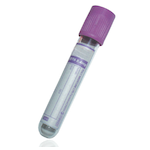Suitable Specimen Types
- EDTA Whole Blood
Sample Processing in Laboratory
UsualSample Preparation
Whole blood - Do not centrifuge. Mix specimens gently prior to analysis
Turnaround Time
48 hoursSample Stability
5 days at 4°CHbA1c (Glycated haemoglobin, GHB)
General Information
Glycohaemoglobin (GHb) is a general term for whole blood glucose complexes that are non-enzymatically bound to alpha and beta chains of human haemoglobin. The most quantitatively prevalent complex is called HbA1C, in which glucose binds to the N-terminus of the alpha chain. The amount of HbA1c formed is directly related to the average level of blood glucose. HbA1c levels do not change quickly due to life span of red blood cells (2-3 months), therefore the HbA1c levels reflects the average blood glucose level during the last 2-4 months. HbA1c measurement is used in the monitoring of diabetes.
In 2011 the WHO advocated the use of HbA1c testing in diagnosing diabetes.
Haemoglobin A1c (HbA1c) testing to diagnose diabetes
An HbA1c of 48mmol/mol (6.5%) is recommended as the cut off point for diagnosing diabetes. A value of less than 48mmol/mol (6.5%) does not exclude diabetes diagnosed using glucose tests.
In patients without symptoms of diabetes the laboratory venous HbA1c should be repeated. If the second sample is <48mmol/mol (6.5%) the person should be treated as at high risk of diabetes and the test should be repeated in 6 months or sooner if symptoms develop.
Situations where HbA1c is not appropriate for diagnosis of diabetes:
ALL children and young people
patients of any age suspected of having Type 1 diabetes
patients with symptoms of diabetes for less than 2 months
patients at high risk who are acutely ill (e.g. those requiring hospital admission)
patients taking medication that may cause rapid glucose rise e.g. steroids, antipsychotics
patients with acute pancreatic damage, including pancreatic surgery
in pregnancy
presence of genetic, haematologic and illness-related factors that influence HbA1c and its measurement (see annex 1 of the WHO report for a list of factors which influence HbA1c and its measurement)
Patients whose HbA1c is under 48 mmol/mol (6.5%)
These patients may still fulfill WHO glucose criteria for the diagnosis of diabetes
The use of such glucose tests is not recommended routinely, but use WHO glucose testing in patients who have symptoms of diabetes or clinically are at very high risk of diabetes.
Notes
Limitations
Lipaemia, uraemia and icterus can all interfere with the assay.
Reference Range
From 1st June 2009 HbA1c units for reporting of results are mmol of HbA1c per mol of haemoglobin (IFCC units - nmol/mol).
Haemoglobin A1c (HbA1c) testing to monitor diabetes
For most adults with diabetes, the HbA1c target is below 48 mmol/mol. Evidence shows that maintaining HbA1c below this level can reduce the risk of developing complications.
Any reduction in HbA1c levels will have beneficial effects on the onset and progression of complications.
Haemoglobin A1c (HbA1c) testing to diagnose diabetes
An HbA1c of 48mmol/mol (6.5%) is recommended as the cut off point for diagnosing diabetes. A value of less than 48mmol/mol (6.5%) does not exclude diabetes diagnosed using glucose tests.
In patients without symptoms of diabetes the laboratory venous HbA1c should be repeated. If the second sample is <48mmol/mol (6.5%) the person should be treated as at high risk of diabetes and the test should be repeated in 6 months or sooner if symptoms develop.
Source of Reference Range
WHOSpecifications
- EQA Scheme?: Yes
- EQA Status: NEQAS
